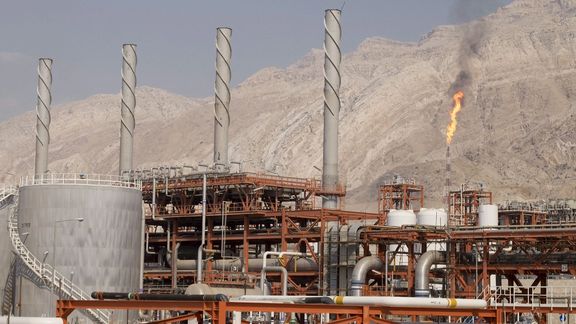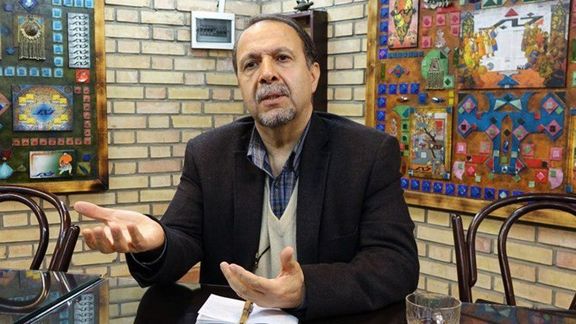Sanctions Hinder China Paying For Iranian Oil - Ex-Envoy

Amid reports of a rise in Iran’s oil exports to China, the regime’s former envoy in Beijing has shed light on Tehran’s mechanisms to collect the revenues.

Amid reports of a rise in Iran’s oil exports to China, the regime’s former envoy in Beijing has shed light on Tehran’s mechanisms to collect the revenues.
Mohammad-Hossein Malaek, who served as Tehran’s envoy for four years under former president Mohammad Khatami, told the Iranian Labour News Agency on Tuesday that China’s purchase of Iranian oil never stopped no matter the status of US and international sanctions on the Islamic Republic.
“China has a principled and consistent approach to its relations with Iran, and for about 10 to 15 years, both when Iran was under sanctions and when they were removed, China has been importing an average of 600,000 barrels of oil per day from Iran,” he said.
However, he explained that Beijing was supposed to open credit lines for Iran, but it never did due to the sanctions. Malaek did not elaborate if these “low-cost credits” were supposed to be earmarked for Chinese products or the regime would have been able to use them on international markets.
No matter how many buyers or how much trade Iran manages to secure for its exports, Iran faces serious obstacles in bringing in the revenues and money transfers due to banking sanctions, the former envoy highlighted.

His remarks came as head of the Iran-China friendship association Allaedin Boroujerdi said Monday, “Necessary agreements have been made between the central banks of the two countries, and we do not have the problem of blocking Iran's money and assets in China, like we have in South Korea.”
While China has a diversified oil supply portfolio that has seen Iran contributing over one million barrels per day in some periods, the lion’s share of China’s daily import of 10 million barrels are from Russia and Saudi Arabia.
He did not explain how exactly Iran is receiving money from China but there are several known methods that have been used in the past, including a barter system and China’s investment in Iran’s development projects. “There is an annual exchange of $15-16 billion worth of goods with the Chinese, some through banking channels and some through barter," Malaek said.
In 2020, Iran and China quietly drafted a sweeping economic and security partnership that would potentially clear the way for billions of dollars of Chinese investments in Iran’s energy and other sectors, undercutting the Donald Trump White House efforts to isolate the regime over its nuclear and military ambitions. Then-foreign-minister Mohammad Javad Zarif and his Chinese counterpart Wang Yi signed the controversial 25-year deal at a ceremony at the Iranian Foreign Ministry in Tehran in March 2021. The deal was first proposed by Iran's Supreme Leader Ali Khamenei during President Xi Jinping’s visit to Tehran in 2016.
The pact has been controversial in Iran because its details have never been disclosed. According to a copy of the draft obtained by The New York Times, the 18-page agreement detailed $400 billion of Chinese investments in banking, telecommunications, ports, railways and dozens of other projects. In exchange, China would receive a regular and heavily discounted supply of Iranian oil for the following 25 years.
Although Iran has not revealed the details of the agreement with China and what it will entail in political, economic and military terms, it has caused resentment from Iranians who claim the Islamic Republic is "selling out the country and its people" to China and Russia.
While oil has been trading at around 75-82 dollars in the past several months, Iran International reported in December that Tehran provides huge discounts to China, charging as little as $37 per barrel. A report by The Wall Street Journal in July said Iran is exporting the highest amount of crude oil in five years, but it offers discounts of up to $30 per barrel.
Kpler, a data and analytics firm, said in its latest report last week that Iran’s oil shipments to China have more than tripled over the past three years despite the US sanctions. Based on the data, Iranian crude exports to its major trade partner have been hovering around one million barrels per day in 2023, up from roughly 325,000 bpd in 2020 and just 160,000 bpd in August 2019, in the wake of tightened US sanctions.
Also in January, the US Energy Information Administration (EIA) put Iran’s average oil production in 2022 at 2.54 million bpd. According to energy consultant SVB International earlier this year, Iran’s crude exports in December averaged 1.137 million barrels per day, up 42,000 bpd from November and the highest 2022 figure SVB has reported based on earlier estimates.
Iran needs around $50 billion from oil exports to balance its flailing budget, but estimates say actual annual proceeds are around $25 billion. Another reason for Iran’s oil revenues being probably less than $25 billion is the costs involved in illicit shipments to evade sanctions, and losing money in trying to repatriate the money in hard currencies. Iran’s banking system is also under US sanctions and any oil revenues are laundered through intermediaries.
The main question that remains unanswered is how all these oil revenues are spent when inflation is still soaring, national currency is on a nosedive and Iranians are getting poorer every day with no prospect of bouncing back in sight.